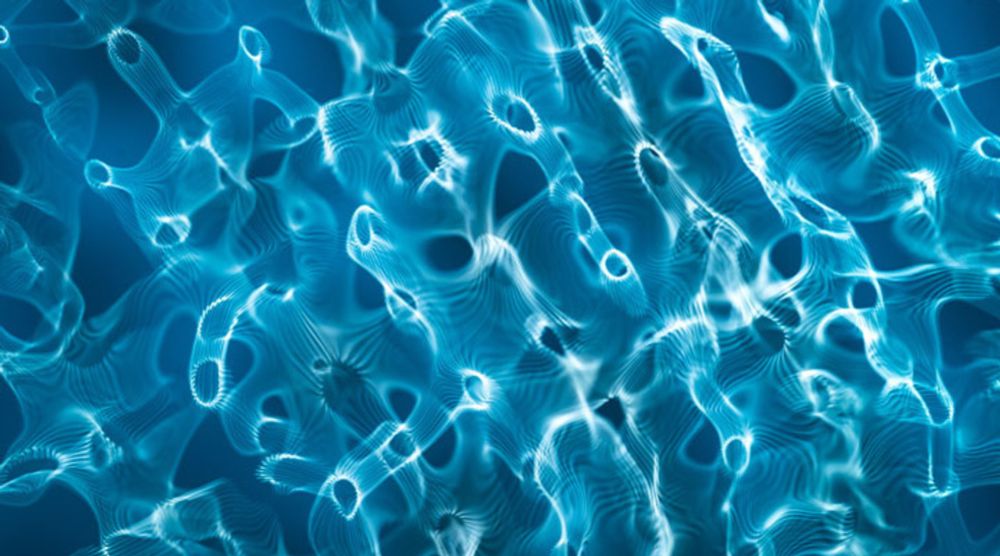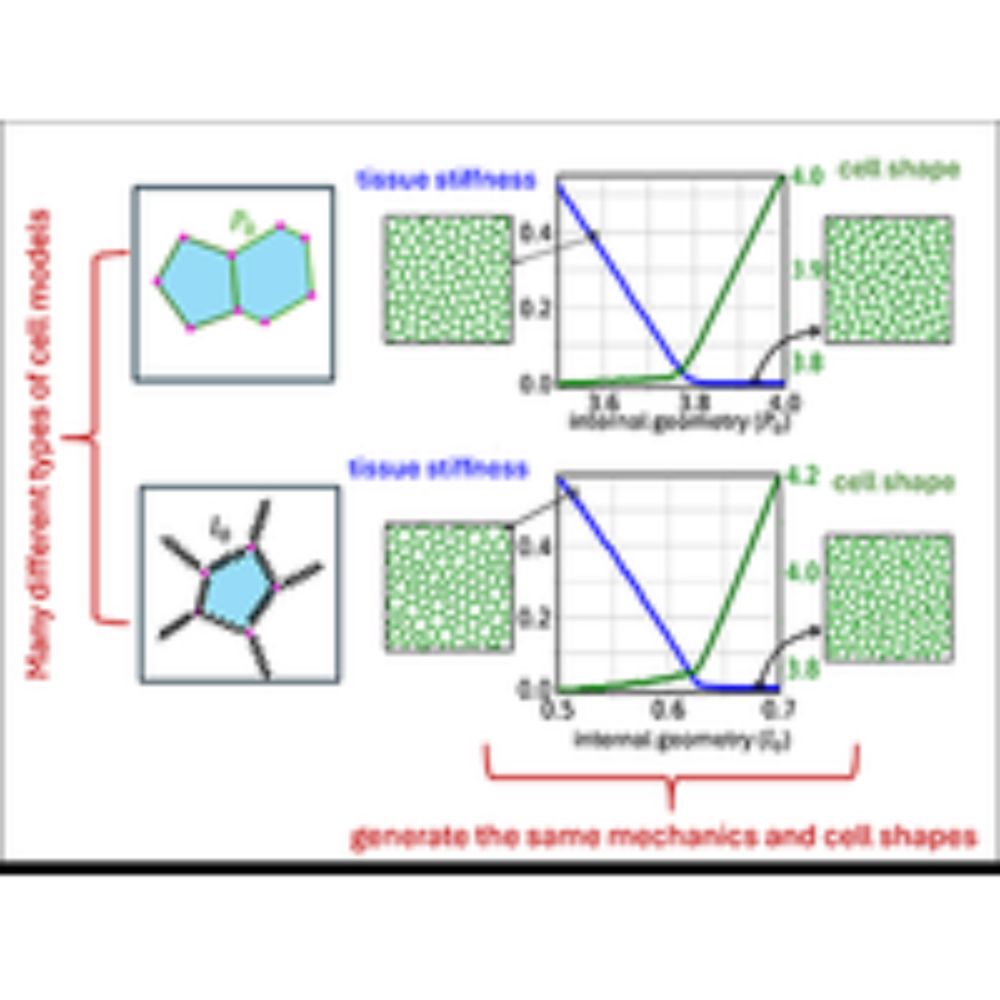Our work confirms that slow tissue movements can generate forces that are significant enough to deform an organ, as the timescale of tissue relaxation is large.
This suggests dynamical forces may be playing a role in many other developmental processes, too. We should look!
13/n
17.07.2025 13:43 — 👍 1 🔁 0 💬 0 📌 0
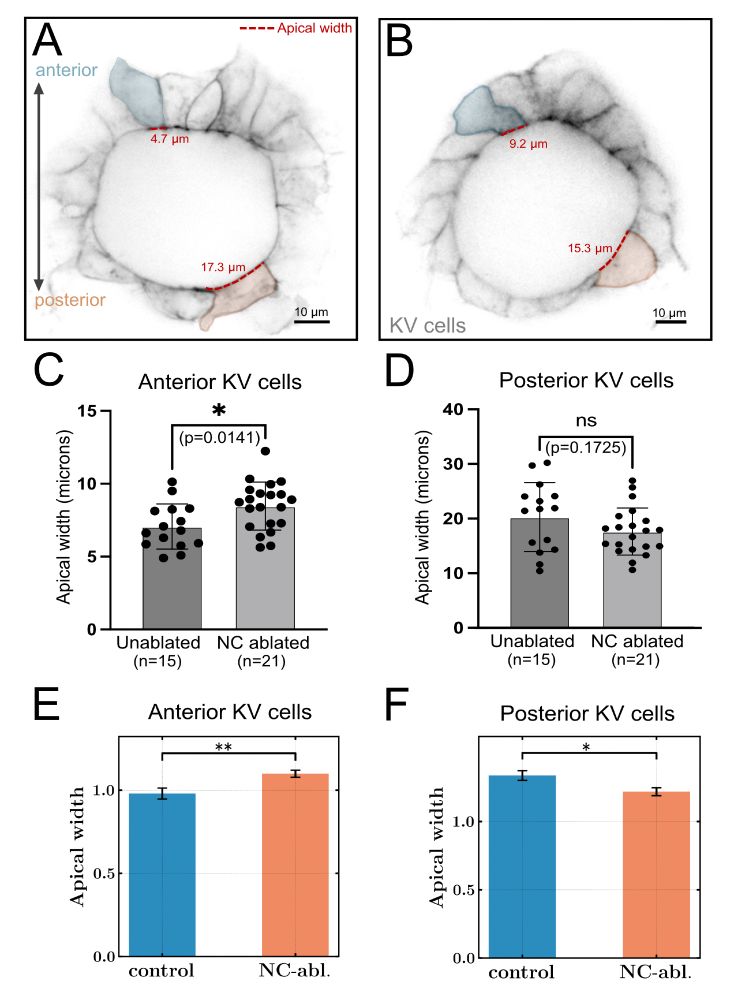
In addition to altering lumen shape changes, are dynamical forces sufficient to change individual cell shapes to drive KV remodeling involved in LR patterning?
Yes, notochord ablation reduces the AP distribution as compared to controls. The 3D vertex model predicts this.
12/n
17.07.2025 13:43 — 👍 1 🔁 0 💬 1 📌 0
These shape changes are generic – they can also be seen in a simpler hydrodynamic model of a membrane surrounded by a highly viscous medium, also with anterior pushing forces and posterior pulling forces.
11/n
17.07.2025 13:43 — 👍 1 🔁 0 💬 1 📌 0
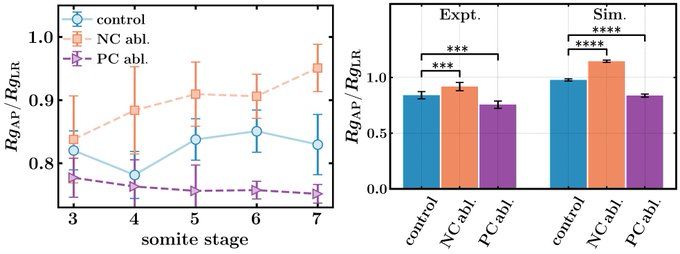
The experiments match the simulation predictions! In notochord ablation experiments, the lumen elongates along the anterior-posterior axis (RgAP/RgLRincreases), while posterior cells ablations extend the lumen along the left-right axis (RgAP/RgLR decreases).
10/n
17.07.2025 13:43 — 👍 1 🔁 0 💬 1 📌 0
We quantify KV shape by the ratio of the radius of gyration of the lumen along the AP and LR directions (RgAP/RgLR).
In simulations, we mimic notochord (posterior cell) ablations by removing the pushing (pulling) forces, and find that the organ changes it shape significantly.
9/n
17.07.2025 13:43 — 👍 1 🔁 0 💬 1 📌 0

In simulations, we identify a set of model parameters (star in phase diagram) that generate the lumen shape seen in control experiments, where KV is pushed from the anterior by the notochord (orange cells) and pulled by posterior cells (purple cells).
17.07.2025 13:43 — 👍 1 🔁 0 💬 1 📌 0
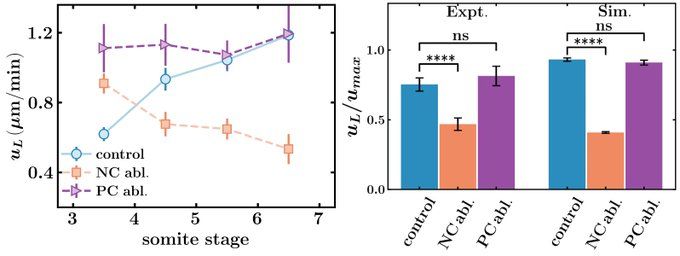
Laser ablation of the notochord reduces the speed of KV in comparison to control experiments. That suggests that we were able to reduce the forces on the KV at the anterior part of KV.
We next ask how these reduced forces affect the shape of the KV lumen and KV cells
7/n
17.07.2025 13:43 — 👍 1 🔁 0 💬 1 📌 0
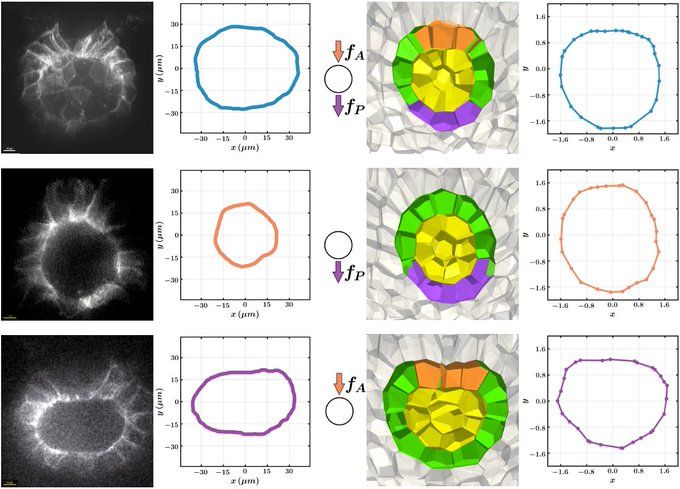
To test our hypothesis, we developed 3D models and laser ablation experiments to:
1) quantify how perturbing structures around KV impact its motion
2) measure cell and organ shape in these cases
3) show that observed in vivo shape changes match those predicted from the 3D model
6/n
17.07.2025 13:43 — 👍 2 🔁 0 💬 1 📌 0
Our hypothesis: The high-viscosity tailbud tissue exerts drag forces on KV as the organ is pushed through the tissue by convergent extension in the notochord, and pulled through the tissue by posteriorly migrating cells. These forces are sufficient to change KV shape.
5/n
17.07.2025 13:43 — 👍 1 🔁 0 💬 1 📌 0
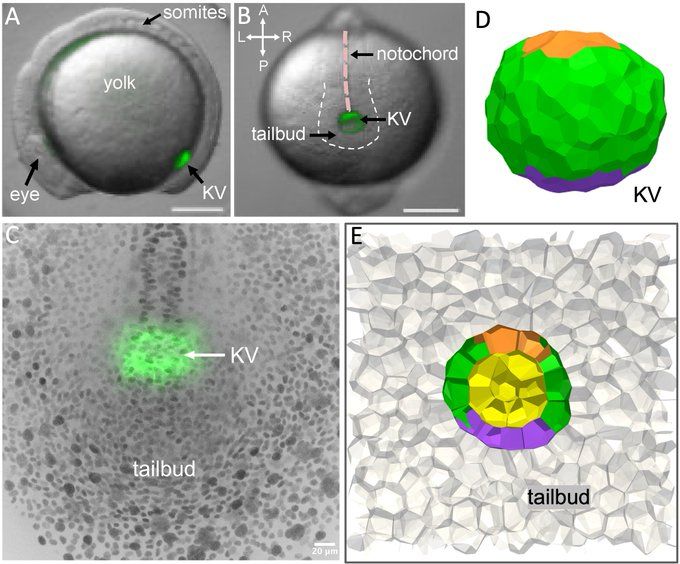
To answer this question, we study Kupffer’s Vesicle (KV). KV is composed of a single layer of epithelial cells surrounding a fluid-filled lumen, located in tailbud of zebrafish, and it moves through surrounding tailbud tissue slowly, at about a micron per minute.
3/n
17.07.2025 13:43 — 👍 1 🔁 0 💬 1 📌 0
A key question in developmental biology is how organisms robustly control the morphology of tissues and organs. Mechanical forces can help provide such a control mechanism, but because tissue motion is so slow, most studies have assumed local force balance. Is that true?
2/n
17.07.2025 13:43 — 👍 2 🔁 0 💬 1 📌 0
This was a fun collaboration spearheaded by @rajphys.bsky.social and Emma Retzlaff, in collaboration with the fabulous Amack Lab and @lovelessradio.bsky.social, in the great environment of @syracuseu.bsky.social
17.07.2025 13:43 — 👍 3 🔁 0 💬 1 📌 0
Yay! New paper out in PNAS: www.pnas.org/doi/10.1073/... . How do dynamical forces generated by tissue movement affect organ morphology changes during embryonic development?
Using Kupffer’s vesicle in zebrafish embryo we showed that dynamical forces produce shape changes in a developing organ.
17.07.2025 13:43 — 👍 11 🔁 2 💬 1 📌 0
What the paper shows is that -- for some key observables -- it doesn't seem to matter which model you choose. The cell shape always predicts the rigidity transition, and the viscoelastic response is the same on either side of the transition.
09.07.2025 17:23 — 👍 0 🔁 0 💬 1 📌 0
But the key point is that we're not sure which of these models is "right" -- some might be right for one cell but not another. So what I mean is that different versions of vertex models are likely "wrong" for certain cell types.
09.07.2025 17:23 — 👍 0 🔁 0 💬 1 📌 0
One way of rationalizing the P^2 term is to say some cell types have a contractile actin ring; another way is to say that there's a limited pool in the cell of, e.g. cadherins or myosin.
09.07.2025 17:23 — 👍 0 🔁 0 💬 1 📌 0
The linear term is a line tension (2D version of a surface tension) but the quadratic term is more mysterious, and some other versions of vertex models remove it. Other versions of vertex models have a spring-like restoring force on each edge, instead of a restoring force on the perimeter.
09.07.2025 17:23 — 👍 0 🔁 0 💬 1 📌 0
We know that cell cortex mechanics is really complex (viscoelastic, with feedback loops, etc.) A standard vertex model makes a specific assumption about that mechanics -- with a term proportional to the perimeter P and a second term proportional to P^2,
09.07.2025 17:23 — 👍 1 🔁 0 💬 1 📌 0
Excited to have a discussion on this topic with outstanding colleagues!
09.07.2025 00:05 — 👍 2 🔁 0 💬 0 📌 0
x.com
Congratulations to graduate student Tyler Hain for his paper accepted to Phys. Rev. E. Here's a link to the tweetorial (on x until we finish migration to bluesky): x.com/ManningResea...
17.12.2024 14:34 — 👍 3 🔁 0 💬 0 📌 0
Fun article in Washington post for kids about Bio-inspired science and engineering at Syracuse University!
x.com/SUBioInspired/…
25.01.2023 17:46 — 👍 0 🔁 0 💬 0 📌 0
While theories (specifically, effective medium theory) exist for networks with disorder in the coordination generated, e.g. by dilution, we couldn't find a theory for regular graphs with geometric/tension disorder. So we developed one!
25.01.2023 13:57 — 👍 1 🔁 0 💬 0 📌 0
Thanks EPL for the highlight for the nice work spearheaded by former Manning group postdoc Ojan Damavandi.
x.com/epl_journal/st…
25.01.2023 13:57 — 👍 0 🔁 0 💬 1 📌 0
Working hard and very interested in promoting "bio-inspired design" funding opportunities in the United States.
x.com/EngineeringSU/…
12.01.2023 19:08 — 👍 0 🔁 0 💬 0 📌 0
A fun and fruitful collaboration with the @WickstromLab with a new preprint and hopefully more fun science in the works. Thanks, team!
x.com/WickstromLab/s…
19.12.2022 01:30 — 👍 0 🔁 0 💬 0 📌 0
Moving Together: Chemotaxis in Clusters
Cells often sense their surrounding microenvironment, including biochemical signaling gradients, and then use that information to change their behavior. Many cell types chemotax, which means they...
Congratulations to Liz Lawson-Keister for a fantastic article and lovely cover art in collaboration with artist Melanie Oventhal. See this blog post for more details:
x.com/syracusephysic… biophysics.org/blog/moving-to…
06.12.2022 23:37 — 👍 0 🔁 0 💬 0 📌 0
Official account of the American Physical Society (APS) Division on Statistical & Nonlinear Physics (DSNP).
Advancing interdisciplinary research in non-equilibrium and statistical physics.
Join now: https://go.aps.org/4eCIyvD
Developmental biologist at UCL
Multicellular Morphogenesis Lab
http://zebrafishucl.org/mongera-lab
Physics, biology, geometry, topology in complex biological networks, tissue mechanics, and morphogenesis. MPI-CBG and CSBD.
Soft matter and biophysics @univie.ac.at. Born in Italy. Welcomed by Austria. On Bluesky to find another Twitter now that Twitter is no more.
Associate Professor and Director of Graduate Studies. GPCRs and gene regulation in pancreatic cancer. Posts are mine.
Account of the Max Planck Institute for the Physics of Complex Systems in Dresden; tweets by Pablo Pérez, Uta Gneisse, and Pierre Haas @lepuslapis.bsky.social.
The official source of Syracuse University news, events, happenings on campus and press coverage involving faculty. Visit news.syr.edu to read the latest stories, subscribe to SU Today, discover the latest “’Cuse Conversations” podcast episodes and more! 🍊
Fostering a vibrant, inclusive, and global community dedicated to science and society. Join us: http://go.aps.org/2NWWEeY
she's a purple-loving soft-matter physicist at NC State who dabbles in geophysics and engineering and textiles and food
Softbites brings you digestible summaries of the latest #research in #softmatter🔬#scicomm
Big dumb nerd baby
(he/him/cis)
https://linktr.ee/axelofthekey
Studying cells inside embryos since way before it was cool.
https://www.wallingfordlab.org/
ISDB is a non-profit scientific association that promotes the study of developmental biology
How are biological forms encoded? Group leader at IBDM Marseille, director of Turing Center for living systems (CENTURI). Professor at Collège de France, Paris: Dynamics of living systems
Using molecular biophysics, biochemistry, and cell biology to understand the intersection of protein quality control mechanisms and neurodegenerative disorders (ALS, FTD); IDPs, Ub biology, UBQLNs
Neuroscientist @Harvard asking how sensation and action are entwined to facilitate cognition. Natural behavior, circuits for scents and movement, curiosity, biological and artificial intelligence
ICREA Research Professor at Universitat de Barcelona. Research Group Leader at MPI-PKS and CSBD in Dresden. Theory of living matter. Collective phenomena in biology through the lens of active matter physics.
Computational biophysics, cell motility, collective motion, soft matter, horses, cats. Associate Prof at Johns Hopkins Physics+Biophysics departments.
Professor of Biophysics -
@ISTAustria Using physics to understand biological questions, such as how embryos grow!
Soft Matter Physics meets Chemistry and Engineering. Physics Education. Eindhoven University of Technology. Music. Games. Cooking.
 17.07.2025 13:55 — 👍 3 🔁 0 💬 0 📌 0
17.07.2025 13:55 — 👍 3 🔁 0 💬 0 📌 0









